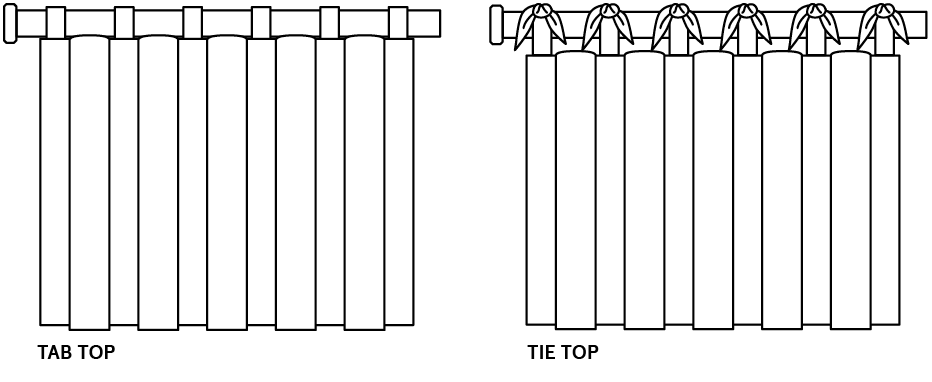
A top style refers to how your drapes are pleated (or not pleated) at the top. Different types of pleat styles can change the look of your drapes and how they function.
Are you looking for something traditional, something modern or something casual? This style decision will influence which top style you choose.
The options can be overwhelming, so we are breaking down the different styles below:
Pinch Pleats:
Pleats are spaced evenly across the panel and "pinched" at either 4" or 6" below the top depending on the length of your panel (this can also be customized!). A good rule of thumb: longer panel, larger pinch. The pleats create fullness and ensure you have uniform folds. You can choose a double or a triple pinch.
Style: Classic, traditional (but still feels contemporary)
Also known as: Two-finger pleats, three-finger pleats, French pleats
Note: Some very thick fabrics cannot be pinched, but we can help advise.




Top Pinch Pleats:
Pleats are spaced evenly across the panel and "pinched" at the top, allowing the pleat to flare out. The pleats create fullness and ensure you have uniform folds. You can choose a double or a triple top pinch.
Style: Tailored, traditional
Also known as: Euro pleats, fan pleats
Note: Some very thick fabrics cannot be pinched, but we can help advise.



Inverted Pleats:
The inverted pleat allows you to create fullness with the pleats but has a more streamlined look. The pleats are stitched in the back giving you a flat-faced front.
Style: Modern, contemporary
Also known as: Box pleats



Ripplefold:
The ripplefold is a popular style that is well-loved by architects and designers. It has a signature "S" fold. The top is constructed with a snap tape that attaches to a track. This allows for a very smooth glide. The hardware is very minimal allowing the eye to focus on the fabric. It is often considered when drapes are tucked into a recessed ceiling, completely eliminating the view of the hardware.
Style: Minimal, sleek, hotel-chic
Also known as: S fold
Note: Ripplefold panels require specialty hardware.



Flat Panel:
A flat panel has no pleats, folds or pockets. It is an economical choice and can look clean and modern. It takes a little adjusting to get the ripples and volume to sit evenly on a flat panel.
Style: Simple, casual
Note: We still add fullness to a flat panel so it doesn't look like a "bedsheet" when closed, you will still have ripples and folds.



Grommets:
You can opt for grommets instead of traditional drapery rings giving you a lofty look. The volume and drape will be similar to a flat panel.
Style: Casual, industrial
Note: Your panels will extend above the drapery pole. That space will need to be considered when installing the rod height.


Pole Pocket:
This is a very budget-friendly option because there is no need for rings or drapery hooks. A pocket is simply sewn into the header allowing you to slide the panel over the rod. It will organically create folds and gathers. We like this style for shorter café curtains. If you plan on opening and closing your drapes often, we do not recommend this style as the panels will not glide as easily across the rod as other top styles. It is recommended for panels that will be stationary most of the time.
Style: Casual, simple
Note: To remove the panel, you will need to remove the rod from the brackets.


Tab & Tie Tops:
Tabs have been a popular style for decades! Tabs or ties are sewn into the panel to attach to the rod instead of rings. It is not a great option if you plan on opening and closing your drapes often as they do not glide as easily as rings.
Style: Casual, cottage vibes
Notes: This seems like a budget-friendly option because of the lack of rings and hooks, but the labour costs to create the tabs will likely cost more than the rings.



Pencil Pleats:
Small gathered pleats are created by sewing in a drapery tape that can be uniformly gathered to the desired width. Traditional hooks and rings are still used but these panels would be considered stationary and not operational due to the fixed pleats.
Style: Boho, eclectic
Also known as: Gathered pleats, shirred pleats
Notes: This style looks beautiful with sheers or light fabrics, creating a breezy effect.


